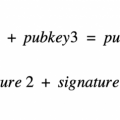For digital objects such as files or text, it is easy to create a duplicate. In a couple of clicks or tapMultiple keys can copy any number of files from one location to another. This makes digital devices very simple and useful for the average user.
But for monetary units it is free to createDuplicates are definitely not a desirable quality. I would not want to have a monetary system that would allow anyone to copy and multiply monetary units at their discretion. This describesdouble spending problem(double spend):How can the recipient of digital money be sure that the same monetary units were not simultaneously sent to someone else? And how can all participants in the monetary system be sure that others do not duplicate monetary units at will?
With physical money the problem of doublespending does not arise with such urgency. The same physical note or coin cannot be in two places at the same time. The problem of double-spending occurs only in digital systems, where the same file or data can be easily copied and stored in multiple locations at the same time. That is, the problem of double spending was not always so urgent. It gained fundamental importance when transferring money into digital form.
Solutions
To maintain trust in digital cashsystems, two types of solutions to the double spend problem have emerged. The former rely on trusted centralized authorities to prevent double-spending and other types of fraud. The second type of solution rejects centralized power as an idea and allows anyone in the system to independently verify all transactions for double-spending.
Trusted third parties
In order to prevent fraudulent transactions,such as double spending, users trust certain organizations to verify all transactions privately. These organizations include payment systems, banks, automated clearinghouses, and ultimately central banks. Each such organization maintains its own ledger of records and applies its own rules to validate transactions.
Banks and payment systems are accountable to the localcentral bank and government. For this reason, they usually act in good faith. However, maintaining such a system is expensive. Most financial institutions charge commissions and place restrictions on the size, type and number of transactions a customer can perform. In addition, the final settlement of transactions, depending on their type, can take from 30 to 90 days.
Distributed ledger
Bitcoin Solves the Double Spending Problem withusing a decentralized registry of records that anyone can access. By being able to check the complete history of transactions, Bitcoin network participants can be sure that their digital coins (like the coins of other users) have not been spent twice.
Sending BTC from one user to anotherinvolves the destruction of the sender's coins and the creation of new coins belonging to the recipient. The operation of destroying the sender's coins is recorded in the public register so that the user can no longer send the same coins to someone else.
Bitcoin is an open system, that is, anycan start using the network without any admission or maintenance fees. There are no restrictions on the number or size of transactions. In addition, due to the immutability of the blockchain, the final settlement of bitcoin transactions can be achieved in just one hour.
Learn more about how Bitcoin solves the double-spending problem
</p>



